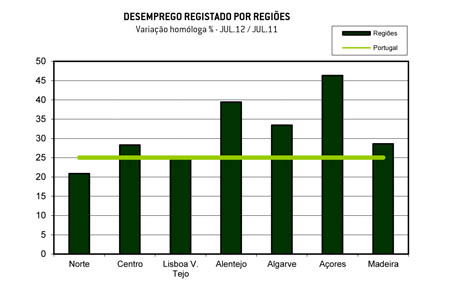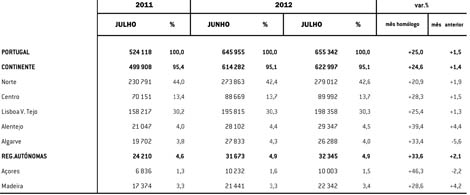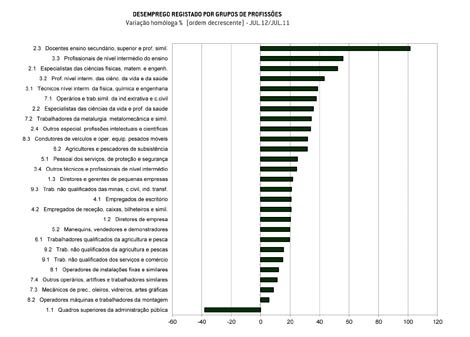 The Algarve was the third region in the country where unemployment increased the most in July, compared to the same month last year, as revealed by the Employment and Vocational Training Institute in its Monthly Information on the Employment Market.
The Algarve was the third region in the country where unemployment increased the most in July, compared to the same month last year, as revealed by the Employment and Vocational Training Institute in its Monthly Information on the Employment Market.
The increase was extended to all regions of the country, but was particularly severe in the Autonomous Region of the Azores (+46,3%), in the Alentejo (+39,4%) and in the Algarve (+33,4%).
Despite this year-on-year growth in unemployment, the Algarve recorded the largest monthly decrease in unemployment (-5,6%) compared to the previous month (June 2012). Also in the Azores, there was a decrease (-2,2%). In relation to the Algarve region, this decrease in unemployment in July, when compared to the previous month, should have to do with the seasonality of tourism, which creates more temporary employment.
On the other hand, the Alentejo region was the one with the biggest increase in the number of unemployed compared to the previous month, in percentage terms (+4,4%), followed by the Autonomous Region of Madeira (+4,2%).
Also according to IEFP data, at the end of July 2012, the Employment Centers in Mainland Portugal and the Autonomous Regions had 655 342 registered unemployed, which corresponds to 81,7% of a total of 801 674 job applications.
Compared to the same month in 2011, unemployment rose 25,0% (+131 224). There was also an increase, but more moderate, compared to June this year (+1,5%; +9 387).
The year-on-year increase in unemployment affected men (+31,4%) more than women (+19,5%).
 By age group, it was in the youth segment that annual unemployment increased the most (+36,6%, against an increase of 23,6% in adults).
By age group, it was in the youth segment that annual unemployment increased the most (+36,6%, against an increase of 23,6% in adults).
Unemployed persons registered for less than 1 year increased by 35,4%, in annual terms, while long-term workers registered an increase equivalent to 11,2%.
Year-on-year unemployment grew more significantly in the category of first job (+30,5%), with the percentage increase that took place in situations of search for a new job at 24,6%.
At all levels of education, there was an increase in the number of unemployed, compared to the same period last year. Higher education graduates stand out with an increase of 49,5%, followed by secondary education (+36,2%).
The analysis from the perspective of the unemployed professions, bearing in mind the data collected for the Continent, highlights, once again, the high representation of "service, protection and security personnel" (78 359), of "unskilled workers services and commerce" (70 771), "office workers" (62 852), "workers and similar workers in the extractive industry and civil construction" (59 444) and "unskilled workers in mines, civil construction and manufacturing industry” (54 813).
These five professional groups together represented 52,4% of the total unemployed registered at the end of July 2012.
Unemployment among teachers rose 101,4%
 The comparison with the same month of last year (July 2012) shows that unemployment registered on the mainland has suffered a more significant percentage increase in the professional group corresponding to “teachers of secondary and higher education and similar professions”, with +101,4%.
The comparison with the same month of last year (July 2012) shows that unemployment registered on the mainland has suffered a more significant percentage increase in the professional group corresponding to “teachers of secondary and higher education and similar professions”, with +101,4%.
Only the “higher public administration staff” – a group that is not very significant in terms of total registered unemployment – suffered an annual reduction in the number of unemployed (-38,0%).
With regard to the economic activity originating unemployment, it is observed that, among the 576 unemployed who, at the end of July 284, were registered as candidates for a new job, in the Mainland Employment Centres, 2012 % had previously worked in activities in the “services” sector, with emphasis on “real estate, administrative and support services activities” and “wholesale and retail trade”; 61,6% came from the “industry” sector, especially “construction”; and 34,6% were from the “agricultural” sector.
Compared to July 2011, there was an increase in unemployment in the three major sectors of economic activity, with the percentage fluctuation in the tertiary sector standing out (+26,1%). Disaggregating by subsectors, the percentage increases were more substantial in “construction” (+37,9%), in “trade, maintenance and repair of motor vehicles and motorcycles” (+36,9%), in “activities real estate, administrative and support services” (+34,3%), in “consulting, scientific, technical and similar activities” (+33,8%), in “public administration, education, health and social support activities ” (+30,2%) and in “information and communication activities” (+30,2%).
On the other hand, with the only decreasing year-on-year variation, that is, the only sub-sector where unemployment decreased, there was “textile manufacturing” (-6,8%).


















Comments